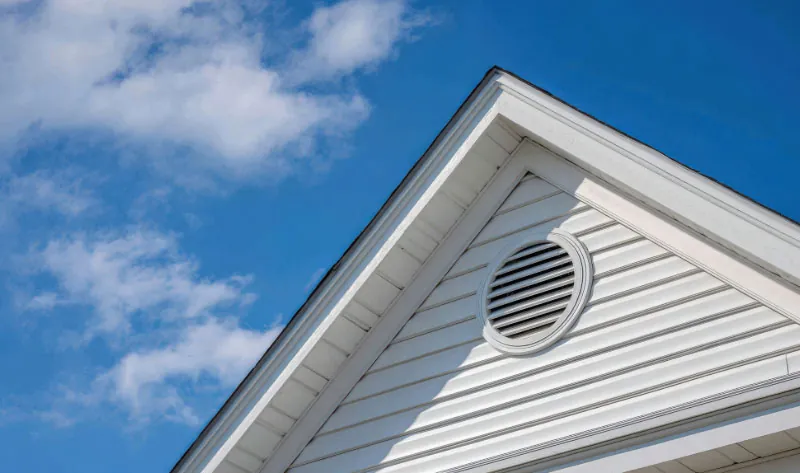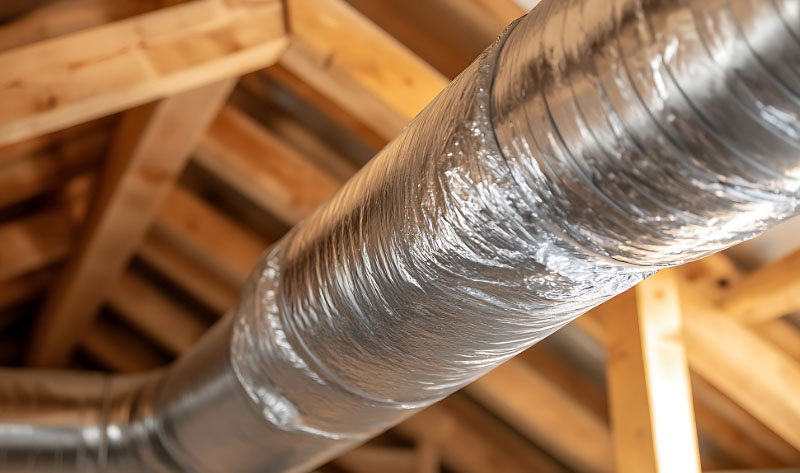The Mold Problem in Virginia Homes
Mold and mildew are more than just annoying. They can damage your home and affect your health if left unattended. In Virginia’s humid climate, many homeowners deal with musty odors, discolored spots on ceilings or walls, and allergy or breathing problems.
While it’s impossible to get rid of all mold spores indoors, there is good news. By keeping moisture under control, you can help keep mold from growing in the first place.
But where is all that moisture coming from? For many Virginia homes, the problem starts in the attic space, and the solution is often a proper attic ventilation system.
Why Attic Ventilation Matters in Virginia

Climate Considerations
In Virginia, we get a mix of hot, humid summers and chilly, snowy winters. These varying weather conditions make attic ventilation more important than you might think.
The Moisture Trap Problem
When heat and moisture rise from your kitchen, bathrooms, or crawl space, they end up in your attic. If the hot air and humidity can’t get out, they collect and condense on cooler surfaces and cause problems like:
- Mold and mildew growth
- Wood rot
- Wet, ineffective attic insulation
Think of your attic as your home’s uppermost layer of defense against the elements. It needs airflow to work properly.
The Ventilation Solution
A ventilated attic gives that warm, damp air a way out. This keeps your attic at an even temperature and drier. It also protects your home’s energy efficiency and structural integrity. Without it, you’ll see higher energy bills in the summer and risk ice dams in the winter. (Ice dams are when snow melts on your warm roof and refreezes at the edge, damaging your shingles and gutters.)
Signs of Improper Attic Ventilation
Watch for these warning signs that your attic might not be well-ventilated:
- Mold and mildew on attic wood or insulation: Black, dark, or fuzzy patches are a big red flag.
- Musty or damp smells in the attic or upstairs rooms: This is an indication of excess moisture and poor air circulation.
- Condensation on windows, rafters, or roof boards: Moisture beads or staining mean humid air is lingering.
- Ice dams on your roof or frost inside the attic: These are signs that warm air is trapped and condensing instead of venting out.
If you notice any of these signs, it’s time to take a closer look at your attic ventilation system.
How Attic Ventilation Works

The Airflow Process
A healthy attic ventilation system uses a mix of intake and exhaust vents:
- Intake vents: Commonly called soffit vents, they let in cooler outside air at a lower part of your attic.
- Exhaust vents: These ridge vents or gable vents near the roof peak let hot air and moisture escape.
This creates a steady flow of air that removes trapped heat and moisture. It allows air to escape, rather than getting stuck.
Building Code Requirements
Most building codes, including Virginia’s residential code, require attic ventilation to reduce moisture and prevent mold or material damage.
Ventilation Ratio Guidelines
A good rule of thumb: for every 150 square feet of attic floor space, you need at least one square foot of vent opening. For example: A 600 square foot attic should have at least four square feet of net vent area, split between intake and exhaust vents.
The most effective setup is to combine continuous ridge vents at the roof peak and continuous soffit vents along the eaves of your attic. This setup lets airflow sweep through the entire attic, keeping things dry and efficient. Always refer to the most up-to-date building code for the most accurate information.
The bottom line is that a well-ventilated attic gives rising hot, moist air an escape route that helps prevent condensation on your roof or insulation.
Benefits of Proper Attic Ventilation
Mold and Mildew Prevention
Moist air leaves through vents instead of soaking into your attic insulation or wood. That removes the damp environment mold and mildew need to grow. This helps keep your attic dry and protects your home from musty odors, mold, and mildew.
Energy Efficiency

Attic ventilation works together with insulation to stabilize your attic’s temperature and create a more energy-efficient home. In summer, venting hot air reduces the strain on your AC while helping to lower cooling costs. In winter, a cooler, drier attic prevents uneven heating and wasted energy.
Longer Roof Lifespan
Excess moisture can seep into your roof decking and damage your roof over time. Ventilation removes moisture before it can rot wood or damage shingles. Plus, good ventilation helps prevent ice dams, protecting your roof and gutters. The result? A dry attic and longer lasting roof structure.
A More Comfortable Home
A well-ventilated attic helps regulate indoor temperatures in your attic and the rooms below. You’ll have fewer drafts in winter and cooler upstairs bedrooms in summer.
Additional Moisture Prevention Tips
Ventilation works best when paired with other moisture control measures.
Vent Exhaust Fans Outdoors
Make sure your bathroom and kitchen exhaust fans vent outside, not into the attic. This is a major cause of attic moisture in humid climates such as Virginia. It’s so important to remove excess humidity from inside your home rather than dumping it into the attic that Virginia’s building code requires it.
Seal Attic Air Leaks
Plug and seal gaps and cracks around pipes, light fixtures, and wiring. This stops warm, moist air from leaking into your attic space, improving your home’s energy efficiency.
Control Indoor Humidity
Keep humidity inside your home between 30–50% year-round. Use dehumidifiers or air conditioning in the summer. You may also want to consider a portable dehumidifier in the attic as an extra precaution.
Fix Water Leaks Promptly
A roof or plumbing leak can create a mold problem fast. Repair leaks and remove any water-damaged materials within 24–48 hours to help prevent mold.
Ensure Adequate Insulation
Ensuring you have sufficient attic insulation helps prevent condensation by keeping surfaces warmer. It keeps your attic temps more stable and increases the effectiveness of your ventilation. It’s important to remember to not block your soffit vents and use baffles to keep air pathways clear.
A combined strategy of attic ventilation, air sealing, and insulation is your best defense against mold, mildew, and moisture problems.
Ventilation and Insulation Go Hand in Hand
Essential Defense Against Moisture
A proper attic ventilation system helps by stopping moisture problems before they start. It won’t guarantee a mold-free home because no system can. But it does allow free airflow through your attic, giving you one of the best defenses against moisture build up.
The Complete System

Creating balanced intake and exhaust vents for ventilation helps create a complete system and a more durable attic by:
- Protecting your roof
- Keeping your attic drier
- Improving energy efficiency
- Keeping your home healthier and more comfortable
Two Approaches to Attics
Attic ventilation always works best alongside proper insulation. Venting out hot summer air and cold damp winter air is only half the battle. You also must stop unwanted heat transfer with good insulation. There are two main approaches to this:
- Vented attic (the most common approach)
- Uses fiberglass or cellulose insulation on the attic floor.
- Requires open soffit vents and ridge vents.
- Unvented (sealed) attic (a ventilation alternative)
- Uses spray foam insulation along the roofline to seal outside air.
- Turns attic into part of your conditioned living space.
- Mechanical ventilation (using ducts and fans) is required instead of traditional ventilation (using attic vents).
You Can Count on Toler Insulating
At Toler Insulating, we’ve been helping Virginia homeowners and contractors create dry, energy-efficient attics since 1994. Our expert team protects homes from mold and mildew, roof damage, and high energy bills with top-quality insulation and ventilation solutions.
We serve the Lynchburg area and beyond with professional, trustworthy service you can count on. Contact us today to schedule your free attic evaluation and find out which insulation and ventilation setup works best for your home.
References
National Weather Service. (n.d.) Preventing roof ice dams. https://www.weather.gov/grr/roofIceDams
United States Environmental Protection Agency. (n.d.). Care for your air: a guide to indoor air quality. https://www.epa.gov/indoor-air-quality-iaq/care-your-air-guide-indoor-air-quality#:~:text=Keep%20indoor%20humidity,on%20the%20humidifier
Virginia Department of Health. (n.d.). Mold. Environmental Health: Public Health Toxicology. https://www.vdh.virginia.gov/environmental-health/public-health-toxicology/mold/
Virginia Cooperative Extension. (n.d.). Attic ventilation. (Publication 2908-9024). Virginia Tech. https://www.pubs.ext.vt.edu/2908/2908-9024/2908-9024.html